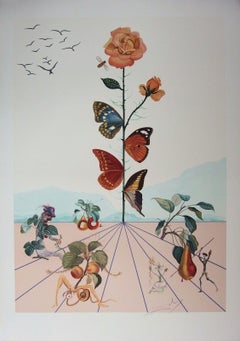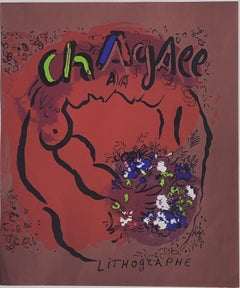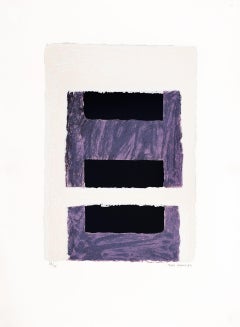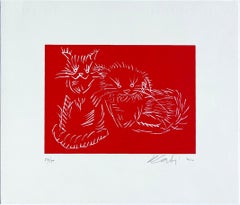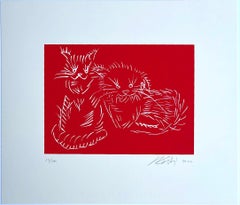Mail Abstract Prints
to
1
1
2
1
Overall Width
to
Overall Height
to
1
1
1
1
1
1
1
4
1
2
1
3
1
1
985
167
120
75
56
53
36
34
34
25
24
24
23
20
19
19
16
15
14
13
3
2
2
1
1
2
3
2
Art Subject: Mail
Salvador Dali - Flordali II, Butterfly Rose
Located in London, GB
Salvador Dali,
Flordali II, 1981
Lithograph on Arches vellum
Edition of 5000
103 x 73 cm
signed in the plate
Catalogue references: Field page 233 / Michler & Lopsinger 1586
This...
Category
1980s Surrealist Animal Prints
Materials
Lithograph
Pablo Picasso ( 1881 – 1973 ) – hand-signed etching on wove paper – 1968
Located in Varese, IT
Grosse Prostituée, Sorcière à la Chouette et Voyageur en Sabots ( Ref: Bloch 1760)
etching on wove paper, Edited in 1968
Limited edition of 50 copies
Current copy numbered: 37/50 on...
Category
1960s Cubist Nude Prints
Materials
Paper, Etching
Lovers with Bouquet, cover of Lithographe I
By Marc Chagall
Located in San Francisco, CA
Artist: Marc Chagall (Russian/French) (1887-1985)
Title: Lovers with Bouquet, Front Cover of Chagall Lithographe vol 1
Date: 1960
Medium: Color Lithograph
Sheet size: 12 7/8 x 10 ¾ i...
Category
1960s Abstract Figurative Prints
Materials
Lithograph
Everything is Shit Except You Love
Located in New York, NY
Stephen Powers
Everything is Shit Except You Love, 2008
17 Color silkscreen on 335 GSM Coventry rag paper.
Hand signed and numbered on lower front. Also bears publishers blind stamp ...
Category
Early 2000s Street Art Figurative Prints
Materials
Rag Paper, Screen
Pilar Araña 1989 signed limited edition original art print silkscreen 30x22 in.
Located in Miami, FL
Pilar Araña
'S/T 1', 1989
silkscreen on paper
30 x 22.1 in. (76 x 56 cm.)
Edition of 75
Unframed
ID: ARA1190-001-075
Hand-signed by author
Category
20th Century Contemporary Prints and Multiples
Materials
Paper, Engraving, Screen
Related Items
“Perro Herido (Wounded Dog)” from 90th Anniversary Suite Lithograph Ed. 22/110
Located in Houston, TX
Abstract surrealist lithograph of a dog wounded by an arrow. This work is from his 90th anniversary suite, the last prints Tamayo completed, before passing on. Signed and editioned a...
Category
1980s Surrealist Animal Prints
Materials
Lithograph
$9,000
H 45.75 in W 51.5 in D 2 in
Cathedral of Christ the Savior. 1989., paper, screen print, 60x32.5 cm
Located in Riga, LV
Cathedral of Christ the Savior. 1989, paper, screen print, 60x32.5 cm
Category
1980s Surrealist Abstract Prints
Materials
Paper, Screen
$852 Sale Price
20% Off
H 23.63 in W 12.6 in D 0.04 in
Original Unused 1964 Avant La Lettre Lithograph Gaspar Room Metras Belarte
By Joan Miró
Located in Miami, FL
Joan Miró (Spain, 1893-1983)
'Sala Gaspar, Metras and Belarte Gallery (avant la lettre)', 1964
Lithograph on Paper (Cahiers d'Art magazine Nº4-5)
Original lithograph without signing ...
Category
1960s Abstract Figurative Prints
Materials
Lithograph
$580
H 39.4 in W 27.6 in
1960s Antoni Tàpies Derrière le miroir cover (Tàpies prints)
Located in NEW YORK, NY
1960s Antoni Tàpies Lithographic cover to Derrière le miroir:
Lithographic publication cover; circa 1968.
11 x 15 inches.
Good overall vintage condition as pictured.
Unsigned from a...
Category
1960s Abstract Abstract Prints
Materials
Lithograph
$200 Sale Price
20% Off
H 15 in W 11 in
Les Voiles (The Sails) /// James Coignard Abstract Text Engraving Modern Art
Located in Saint Augustine, FL
Artist: James Coignard (French, 1925-2008)
Title: "Les Voiles (The Sails)"
*Signed by Coignard in pencil lower right
Year: 1984
Medium: Original Hand-Embellis...
Category
1980s Contemporary Abstract Prints
Materials
Gold Leaf
$400 Sale Price
66% Off
H 20.13 in W 17.63 in
Joan Miró 1970 El Tapís de Tarragona (edition Avant La Lettre) original litho
By Joan Miró
Located in Miami, FL
The work was conceived as a poster for the exhibition "Miró el tapís de Tarragona".
Technical details of the work
Category: Engravings and Prints Graphic Work
Date: 1970
Technique: ...
Category
1970s Abstract Figurative Prints
Materials
Lithograph
Keith Haring Club DV8 poster 1991 (Keith Haring balloon dog)
Located in NEW YORK, NY
Keith Haring Club DV8 San Francisco 1991:
A rare 1991 Club DV8's poster featuring Keith Haring balloon dog artwork originally created by the artist for DV...
Category
1990s Pop Art Animal Prints
Materials
Lithograph, Offset
$540 Sale Price
20% Off
H 24 in W 17 in
Secret Admirer
By Mr Brainwash
Located in London, GB
Mr. Brainwash
Secret Admirer (Red), 2013
4-color screenprint on hand-torn archival art paper
22 1/2 × 22 1/2 in 57.2 × 57.2 cm
Edition of 70
Hand-signed by the artist on the fromt,...
Category
2010s Street Art Figurative Prints
Materials
Archival Paper, Screen
Alvar Sunol Pencil Signed Lithograph C.1970s
By Sunol Alvar
Located in San Francisco, CA
Alvar Sunol Pencil Signed Lithograph C.1970s
Three women around a table
Dimensions 21.5" wide x 12.5" high
The frame measures 32.75" wide x...
Category
Mid-20th Century Abstract Impressionist Figurative Prints
Materials
Lithograph
Serigraphie Fernand Leger
Located in Belgrade, MT
This print is part of my private collection. They were published in a numbered unsigned edition of 1000, and a signed edition of 200, printed by Serifraphie Fernand Leger, Paris and ...
Category
Mid-20th Century Abstract Expressionist Abstract Prints
Materials
Lithograph
Le Girafe en Feu (Field 76-2-A; Michler & Lopsinger 1449), Salvador Dali
Located in Fairfield, CT
Artist: Salvador Dali (1904-1989)
Title: Le Girafe en Feu
Year: 1976
Medium: Lithograph on Arches paper
Edition: CXLII/CCL; 250 Roman Numerals, plus proofs...
Category
1970s Surrealist Abstract Prints
Materials
Lithograph
$4,400 Sale Price
20% Off
H 18.5 in W 25 in
abstract composition
By Marie Raymond
Located in Belgrade, MT
This color lithograph is part of my private collection since the 1970's. Marie Raymond was a pioneer post WWII painter of her generation. She was a lyrical abstractionist of her time...
Category
Mid-20th Century Abstract Expressionist Abstract Prints
Materials
Color, Lithograph
Previously Available Items
Cats (Red), original silkscreen, hand signed 87/150 with official & gallery COAs
By Ai Weiwei
Located in New York, NY
Ai Weiwei
Cats (Red), 2022
Screen print on Saunders Waterford 300gsm paper
Hand signed, dated, and numbered 87/150 by Ai Weiwei on the front
13 1/2 × 17 inches
Unframed
This print was originally published by Kettle's Yard - before it rapidly sold out.
It is accompanied by the Certificate of Authenticity issued by the publisher to the original owner.
The print was editioned by master printer, Kip Gresham at The Print Studio, Cambridge for Kettle's Yard. It was made using an original drawing ‘cut’ into an acrylic sheet. The image is then reversed when printed.
Description from the publisher:
"Drawing has been fundamental to Ai Weiwei’s artistic practice from an early age. He also has a longstanding love of cats, and they appear frequently in the artist’s social media posts. Many cats used to roam his studio in Beijing. As part of the Kettle’s Yard exhibition, Ai’s ‘Cats wallpaper’ (2015) will be displayed in the Castle Street window. This artwork was originally exhibited as ‘Studio Cats’ in the exhibition Andy Warhol / Ai Weiwei at the National Gallery of Victoria in Melbourne, reflecting both artists’ mutual love of cats. For Kettle’s Yard, the drawing of Maple and Birch has been inserted among the other cats depicted on the wallpaper."
Quote from Ai Weiwei:
"I like cats very much because of their independent character, alertness and understanding of human beings; I have feelings approximating to reverence for them. Cats have been regarded as psychic animals since ancient times, no matter in China or ancient Greece. What’s even more interesting is that if a selfie of mine would be seen by 100 people, a cat photo...
Category
2010s Contemporary Animal Prints
Materials
Screen, Pencil
Cats (Red)
By Ai Weiwei
Located in New York, NY
Ai Weiwei
Cats (Red), 2022
Screen print on Saunders Waterford 300gsm paper
Hand signed, dated, and numbered 59/150 by Ai Weiwei on the front
13 1/2 × 17 inches
Unframed
Hand signed, dated, and numbered 59/150 by Ai Weiwei on the front. This print was originally published by Kettle's Yard - before it rapidly sold out.
The print was editioned by master printer, Kip Gresham at The Print Studio, Cambridge for Kettle's Yard. It was made using an original drawing ‘cut’ into an acrylic sheet. The image is then reversed when printed.
Description from the publisher:
"Drawing has been fundamental to Ai Weiwei’s artistic practice from an early age. He also has a longstanding love of cats, and they appear frequently in the artist’s social media posts. Many cats used to roam his studio in Beijing. As part of the Kettle’s Yard exhibition, Ai’s ‘Cats wallpaper’ (2015) will be displayed in the Castle Street window. This artwork was originally exhibited as ‘Studio Cats’ in the exhibition Andy Warhol / Ai Weiwei at the National Gallery of Victoria in Melbourne, reflecting both artists’ mutual love of cats. For Kettle’s Yard, the drawing of Maple and Birch has been inserted among the other cats depicted on the wallpaper."
Quote from Ai Weiwei:
"I like cats very much because of their independent character, alertness and understanding of human beings; I have feelings approximating to reverence for them. Cats have been regarded as psychic animals since ancient times, no matter in China or ancient Greece. What’s even more interesting is that if a selfie of mine would be seen by 100 people, a cat photo...
Category
2010s Pop Art Animal Prints
Materials
Screen
Metropolitan Museum of Art Poster (Hand signed by David Hockney)
Located in New York, NY
David Hockney
Metropolitan Museum of Art Poster (Hand signed by David Hockney), 1988
Offset lithograph poster
Hand signed by David H...
Category
1980s Pop Art Still-life Prints
Materials
Offset
H 36 in W 31 in D 1.5 in
Read More
Joan Mitchell’s Rare, Late-Career Diptych Buzzes with Life
Beneath the inky blackness, the painter’s irrepressible energy electrifies this pair of intaglio prints.
The 1stDibs Guide to Types of Abstract Art
Get to know the key movements and artists who have influenced visual culture for more than a century.
Get to Know the Artists Who Led the Op Art Movement
In the 1960s and '70s, the hypnotic creations of Op artists went mainstream and influenced the look of pop culture.
